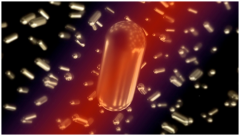A team of researchers from CIC biomaGUNE, Universidad Politécnica de Madrid / Technical University of Madrid and Universidad Complutense de Madrid / Complutense University of Madrid have shown that it is possible to use special lasers to shape gold nanoparticles – millionths of millimetres in size – to enhance their properties to a degree of optical quality never seen previously.
As Andrés Guerrero-Martínez, a Ramón y Cajal Researcher at Universidad Complutense de Madrid, explains: “By using highly intense, ultrafast lasers of extremely short duration – one thousand billion flashes per second – we have achieved a world record in optical quality and succeeded in making all the reshaped nanoparticles behave as clones”.
Apart from achieving a record in optical quality in which thousands of millions of gold nanoparticles behave as one, the research findings, published in Science magazine, represent a new paradigm for manipulating and improving nanomaterials, using lasers as chisels in the hands of a sculptor.
The study also provides the key physical and chemical parameters that need to be understood and controlled to obtain nanomaterials which may be considered as “perfect”, in terms of their optical properties.
Luis Liz-Marzán, Scientific Director and Ikerbasque Research professor at CIC biomaGUNE and leader of a CIBER-BBN research group, further explains: “Our research focuses on the production of gold nanoparticles for applications in biomedicine, on the basis of the ability of those nanoparticles to absorb and scatter light of a particular colour depending on their geometry. Together with many other research groups worldwide, we have been trying for the last 15 years to obtain identical nanoparticles, all of the same colour, to enhance their application in terms of greater efficiency. In this case, our work has been focused on the use of gold nanorods, where minimal variations in length and width bring about significant changes in the colour of the light they absorb”.
Possible applications
The applications of nanoparticles are based on their ability to absorb and scatter light of a specific colour, with high efficiency. These effects, referred to as plasmon resonances, generate optical properties unattainable with bulk metals, even in the millimetre scale, and can be harnessed for a wide range of useful and, in several cases, hitherto impossible applications. Not only can the light scattered by these particles be used in medicine to diagnose diseases, but also the absorption of the light can be used to release heat, for example, for local tumour treatment, thereby minimizing the typical side effects of current treatments.
Plasmonic particles may also be applied in areas such as IT, energy generation and environmental pollution control, amongst others.
Despite the considerable work done in this area to date, it had not previously been possible to produce gold nanoparticles of identical behaviour. “The achievement of this target and the explanation of the mechanism behind it represent a change of mindset that may usher in a new paradigm in the development of nanomaterials with enhanced properties and applications”, according to Ovidio Peña Rodríguez, researcher at the Universidad Politécnica de Madrid.
The research findings are the result of a collaborative study between a consolidated research group (Luis Liz-Marzán in CIC biomaGUNE, San Sebastián) and two emerging research groups (Ovidio Peña-Rodríguez at Universidad Politécnica de Madrid [UPM] and Andrés Guerrero-Martínez at Universidad Complutense de Madrid [UCM]). Other researchers from UPM (Antonio Rivera de Mena) and UCM (Luis González-Macdowell, Mauricio Alcolea Palafox, Gloria Tardajos, Luis Bañares and Jesús González-Izquierdo) have also participated. Special mention must be made of the contribution of the PhD student Guillermo González-Rubio (co-directed by Liz-Marzán and Guerrero-Martínez), who can be credited with being the first to observe the phenomenon in the course of his experiments. Other significant contributions have also been made by the students Pablo Llombart (UCM) and Pablo Díaz-Núñez and Alejandro Prada (UPM). Finally, the use of the facilities at CIC biomaGUNE, at the Centro de Supercomputación y Visualización de Madrid / Madrid Supercomputing and Visualisation Centre (UPM) and at the Centro de Láseres Ultrarrápidos / Ultrafast Lasers Centre (UCM) played an essential role in the successful development of this research study.
Apart from the chemical methods (in solution) to prepare the gold nanoparticles, the truly groundbreaking concept of this work has been the application of ultrafast lasers to reshape the geometry of the particles and the perfection of their properties. We used standard characterization techniques (spectroscopy and electron microscopy), as well as new theoretical models and advanced computer simulation techniques, to understand the chemical and physical nature of the shaping process.

